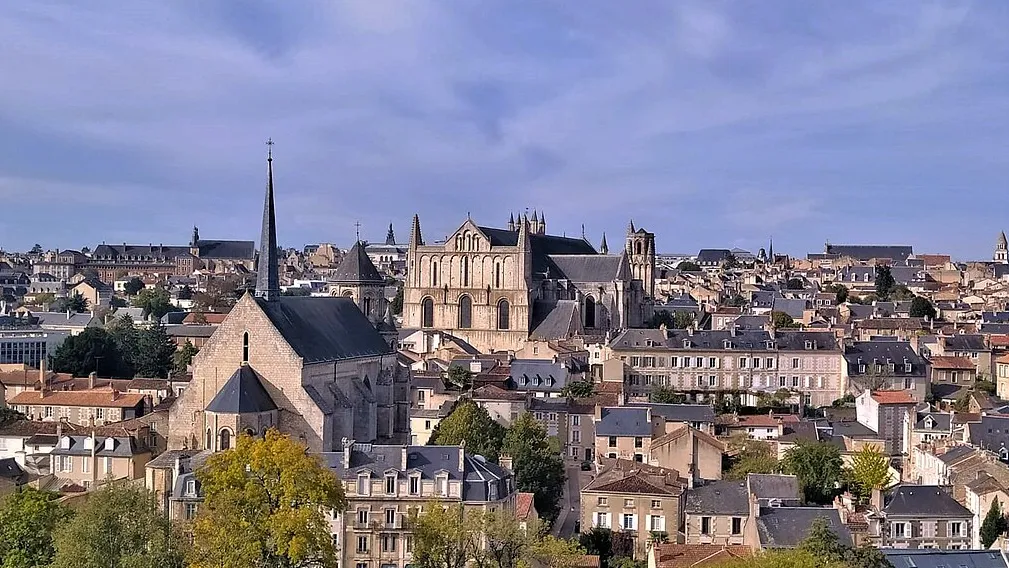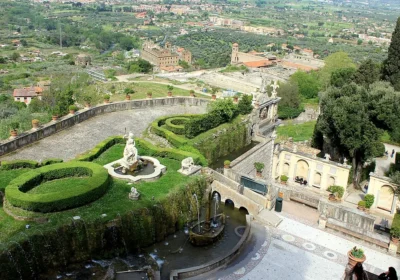Poitiers (Poitiers, ancient Limonum) – a city in France, on the river Maple (Loire basin) – the main city of the historical region of Poitou and the administrative center of the department of Vienne, quite a large and lively city. On the site of a fortress of the Celtic tribe Pictavius in the Gallo-Roman era, it emerged as the city of Limonum (Limonum). It was one of the most important Roman metropolises in Aquitaine.
Poitiers is rich in Celtic, Roman and medieval building monuments: the ruins of a Roman aqueduct have survived and until 1857 a Roman arena could still be seen. On the other side of the Maple is the so-called “Pierre levée” – a dolmen (so called one of the types of megalithic (made of large stones or stone slabs) ancient monuments, similar to stone tables (whence their Celtic name, dolmen, in Brittany) and recognized earlier by archaeologists as altars or altars of the Druids, but were in fact stone tombs of the prehistoric era), which is associated with many ancient legends and superstitions.
At the dawn of Christianity here was erected the chapel of St. John the Baptist (Baptistere Saint-Jean) – the oldest example of Christian architecture in France, now a museum of Merovingian art (a conventional name for the art of a number of regions of France (mainly northern and central), united in the V-VIII centuries. Merovingian state, used the traditions of late antique, Gallo-Roman art, as well as the art of barbarians). Over the centuries of its existence, the chapel has “burrowed” into the ground. In the center of its hall is an octagonal font. In the XI-XII centuries, during the heyday of the pilgrimage route Saint Jacques de Compostelle (Saint Jacques de Compostelle), numerous Romanesque churches were built in Poitiers and the surrounding area.
To this period belongs the main attraction of the city – the church Notre Dame la Grande (Notre Dame la Grande XI-XVI centuries). Every summer evening, the original appearance of the church is reproduced through artistic laser projection: biblical characters come to life. Attention should be paid to the Romanesque Cathedral of St. Peter (Cathédrale Saint-Pierre) in the bishop’s quarter, the beginning of construction which dates back to the end of the XII century, the church of St. Radegunda – Ste.-Radegonde (XI-XIV centuries.) with an underground chapel (which houses the tomb of Queen Radegunda), St. Hilaire le Grand (XI-XII centuries.). The palace of the Counts of Poitou (XII-XV centuries.) deserves attention.
Nearby is the oldest in the West Abbey Liguge (Liguge), a medieval village Nouaille-Maupertuis (Nouaille-Maupertuis) with a Romanesque church built on the territory of the Benedictine abbey, where there is a tomb of St. Junien (Saint Junien).
It was here in the IX-XVIII centuries that battles took place that shaped the history of France for many centuries. At the end of the V century Poitiers was the residence of the Visigothic king Alaric II. In 507, the Frankish king Chlodwig defeated the Visigoths at Vouillé near Poitiers, which ensured the capture of southwestern Gaul by the Franks. The city became a major center of the Frankish kingdom. In 732 in the place of Musse between Poitiers and Tours, the Frankish heavy cavalry of Charles Martell surrounded and defeated the Arab army invading from Spain, forcing it to withdraw to the Pyrenees and stopped the Arab advance in Europe, after which Poitiers became the main city of the county of Poitou.
Museums: fine arts (mainly French school), Sainte-Croix (Sainte-Croix) – rich archaeological collections and a collection of paintings and sculpture, modern scientific and technical. Botanical Gardens, the picturesque Parc de Blossac (Parc de Blossac) and Smarves (Smarves)…
Poitiers was the Aquitanian residence of the Hospitaller Order. The trials of the Templars and Joan of Arc took place in one of the halls of the Palace of the Dukes of Aquitaine (Counts of Poitou), now the Palace of Justice (built in the early XIII century, significantly expanded and rebuilt in the XIX century).
Every year a festival on the theme of the Middle Ages is held here and battles of the Hundred Years’ War are played out. To the south of Poitiers are the abbeys of St. Benoit and Fontenay le Comte, where François Rabelais was tonsured as a monk at the age of twenty-five.
The towns surrounding Poitiers – Châtellerault, Chauvigny, Saint Savin …, are also worthy of the inquisitive tourist’s attention as keepers of priceless pieces of ancient culture, history and architecture.
Seven kilometers from Poitiers – Park Futuroscope (Futuroscope). A paradise for dreamers and sci-fi lovers, it offers a glimpse into tomorrow through numerous rides and shows with lights, music, three-dimensional space and computer games. An exciting journey through space, time, human values and knowledge.
The symbol of Futuroscope is a white ball on a glass pyramid – Solido. The ball is built on the basis of the proportions of the golden section. The park is dedicated to visual technologies: dynamic, three-dimensional, popular science, adventure and simply interesting movies.
The European Park of new audiovisual technologies Futuroscope is a place for walks and recreation for the whole family. It merges nature and architecture to create a unique space. Spread over 100 hectares, spheres, cubes and mirrors are in perfect harmony with water, trees and flowers, creating original and surprising perspectives.

















